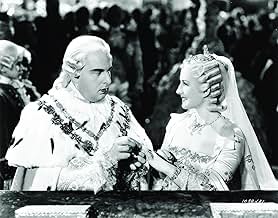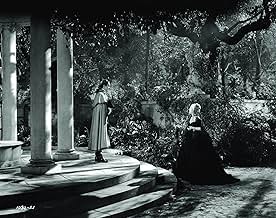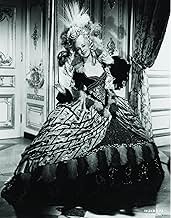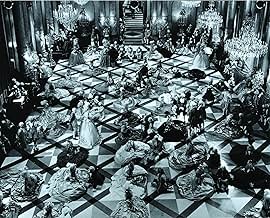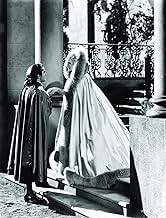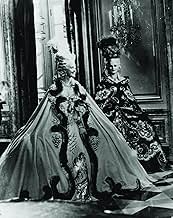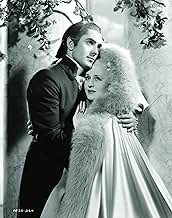IMDb RATING
7.3/10
3.5K
YOUR RATING
The tragic life of Marie Antoinette, who became queen of France in her late teens.The tragic life of Marie Antoinette, who became queen of France in her late teens.The tragic life of Marie Antoinette, who became queen of France in her late teens.
- Nominated for 4 Oscars
- 5 wins & 5 nominations total
Albert Dekker
- Comte de Provence
- (as Albert Van Dekker)
Featured reviews
Here at The Rag, we've learned our lesson: No matter what, give a movie a chance. Just give a movie ten minutes, and if you still hate it as much as you thought you would, feel free to turn it off. If the movie stars an actress you despise, contains a supporting cast you don't normally like, and centers on a subject of which you have no interest, you just might find yourself riveted and impressed. What movie made us learn our lesson? Marie Antoinette, starring Norma Shearer, someone whose movies we'd previously avoided.
The first fifteen minutes of this movie are incredible. Adrian's costumes belong in a museum, as gown after gown after gown are breathtaking, and surprisingly did not bring home an Oscar for the remarkable designer. The Academy Awards didn't have an Oscar for costume design until 1948, which, when you think of all the incredible costumes present in the 1930s and 1940s, is shocking. The art direction, while awarded with a nomination, was passed over in favor of The Adventures of Robin Hood. The incredible sets laden with paintings, chandeliers, rugs, beautiful dishes, jewels, ballroom decorations, draperies, bedroom pieces, and other furniture, was passed over for a forest. When you watch this movie, you'll realize how silly that is. Another silliness is the lack of nominations for Best Picture and Best Director for W.S. Van Dyke. This is a large-scale, expensive, lush epic, and it's ridiculous to look back at Frank Capra's wins for You Can't Take It With You when Marie Antoinette wasn't even nominated.
This heavy epic chronicles Marie's time from age fourteen until her death. Norma Shearer is given an enormous amount to do, and she does it very well. She has to be giddy and young, excited for her marriage, disappointed, afraid, frivolous, betrayed, in love, a mother, and finally, destroyed. As a young girl, she gets betrothed to the soon-to-be King of France, and her wedding night with Robert Morley is an especially emotional scene. They both give excellent performances, and since I normally can't stand either, it's quite a compliment from me. Robert is simple and an introvert who doesn't want to expose himself to potential ridicule, and Norma just wants to be a good wife. When she realizes her marriage will be different than promised, she turns to material pleasures and surface relationships to make her happy.
With a supporting cast of Joseph Schildkraut as an enormously slimy villain, Gladys George as the famous du Barry, John Barrymore as an ailing king, Tyrone Power as the pretty but poorly acted love interest, and Henry Stephenson as a sympathetic ear, there are plenty of varied scenes in this long movie to keep you interested. As one of the earliest films to have an intermission, overture, and entr'acte, this takes a bit of the epic factor out of the following year's Gone With the Wind, which boasted of being the grandest epic of all time. Marie Antoinette is one of the great classics that is dramatic without being grotesque and manages to win you over even if you don't expect to be. Well done, Norma.
The first fifteen minutes of this movie are incredible. Adrian's costumes belong in a museum, as gown after gown after gown are breathtaking, and surprisingly did not bring home an Oscar for the remarkable designer. The Academy Awards didn't have an Oscar for costume design until 1948, which, when you think of all the incredible costumes present in the 1930s and 1940s, is shocking. The art direction, while awarded with a nomination, was passed over in favor of The Adventures of Robin Hood. The incredible sets laden with paintings, chandeliers, rugs, beautiful dishes, jewels, ballroom decorations, draperies, bedroom pieces, and other furniture, was passed over for a forest. When you watch this movie, you'll realize how silly that is. Another silliness is the lack of nominations for Best Picture and Best Director for W.S. Van Dyke. This is a large-scale, expensive, lush epic, and it's ridiculous to look back at Frank Capra's wins for You Can't Take It With You when Marie Antoinette wasn't even nominated.
This heavy epic chronicles Marie's time from age fourteen until her death. Norma Shearer is given an enormous amount to do, and she does it very well. She has to be giddy and young, excited for her marriage, disappointed, afraid, frivolous, betrayed, in love, a mother, and finally, destroyed. As a young girl, she gets betrothed to the soon-to-be King of France, and her wedding night with Robert Morley is an especially emotional scene. They both give excellent performances, and since I normally can't stand either, it's quite a compliment from me. Robert is simple and an introvert who doesn't want to expose himself to potential ridicule, and Norma just wants to be a good wife. When she realizes her marriage will be different than promised, she turns to material pleasures and surface relationships to make her happy.
With a supporting cast of Joseph Schildkraut as an enormously slimy villain, Gladys George as the famous du Barry, John Barrymore as an ailing king, Tyrone Power as the pretty but poorly acted love interest, and Henry Stephenson as a sympathetic ear, there are plenty of varied scenes in this long movie to keep you interested. As one of the earliest films to have an intermission, overture, and entr'acte, this takes a bit of the epic factor out of the following year's Gone With the Wind, which boasted of being the grandest epic of all time. Marie Antoinette is one of the great classics that is dramatic without being grotesque and manages to win you over even if you don't expect to be. Well done, Norma.
A legend in France tells that Julien Duvivier was involved in this film;if he really did something,it was probably minimal;an educated man like him would have been scared by the numerous historical errors of the film.
Here are some of them: -Never Louis XV spoke of sending the dauphine back to where she once belonged,in Austria.The quarrel with Madame du Barry is pure fiction:M.A. spoke once to the favorite ,she said " There are many people here today in Versailles."She never addressed her afterward.
-Louis XVI was not the moron we see in the film.He was actually an educated man.When he was in jail,he would teach his son maths,history ,geography and other subjects.He was not made to be king,that's true ,and all that follows Louis XV 's death is accurate .He reportedly said to his distraught wife :"What a misfortune,we're too young to reign!".He used to go hunting (his favorite pastime) but he was not the half-wit depicted in Van Dyke's film.
-The Royal family was not imprisoned in Le Temple just after the night of Varennes.That escape took place on the 20th of June 1791.The storming of the Tuileries (not included in the movie for a good reason)happened on August ,the 10th 1792;the fall of the monarchy and the Republic followed in September the same year.
-But the queen's last night takes the biscuit!Fersen in her dungeon,no less!
Forget history,and you have a wonderful show,a novel based on M.A.'s life.There are many remarkable things all along the viewing: M.A. in the corridors of her palace,in Vienna ,where her mother tells her "You shall be queen of France" . The sentence will come back ,quite rightly so,in the last pictures.
The affair of the necklace,told in admirable succinct style;the scene when the queen learns that the cardinal de Rohan is free ,while arriving at the opera theater,is a great dramatic idea.
The longest night of June,which tragically ended in Varenne is given an adequate dark treatment where only the torches lighten the forest or the village.
The scene which climaxes the movie is the Royal family's last supper.Here Robert Morley transcends the limitation he is working under ,and makes Louis XVI a clever sensitive man :the rapport he has with his child was obvious in real life and all rings true.The broken soldier's story will intensely move you.Besides ,it was a good idea to film M.A.'s and the dauphin's separation just after the king's death (actually ,the king died on the 21th of January 1793,and M.A. was separated from her child in the following Summer) cause it increases tenfold the queen's tragedy.This scene lasted one hour!one hour! When she left LE Temple for la Conciergerie (where you can visit her dungeon today),the queen said:"Nothing can hurt me now."
Here are some of them: -Never Louis XV spoke of sending the dauphine back to where she once belonged,in Austria.The quarrel with Madame du Barry is pure fiction:M.A. spoke once to the favorite ,she said " There are many people here today in Versailles."She never addressed her afterward.
-Louis XVI was not the moron we see in the film.He was actually an educated man.When he was in jail,he would teach his son maths,history ,geography and other subjects.He was not made to be king,that's true ,and all that follows Louis XV 's death is accurate .He reportedly said to his distraught wife :"What a misfortune,we're too young to reign!".He used to go hunting (his favorite pastime) but he was not the half-wit depicted in Van Dyke's film.
-The Royal family was not imprisoned in Le Temple just after the night of Varennes.That escape took place on the 20th of June 1791.The storming of the Tuileries (not included in the movie for a good reason)happened on August ,the 10th 1792;the fall of the monarchy and the Republic followed in September the same year.
-But the queen's last night takes the biscuit!Fersen in her dungeon,no less!
Forget history,and you have a wonderful show,a novel based on M.A.'s life.There are many remarkable things all along the viewing: M.A. in the corridors of her palace,in Vienna ,where her mother tells her "You shall be queen of France" . The sentence will come back ,quite rightly so,in the last pictures.
The affair of the necklace,told in admirable succinct style;the scene when the queen learns that the cardinal de Rohan is free ,while arriving at the opera theater,is a great dramatic idea.
The longest night of June,which tragically ended in Varenne is given an adequate dark treatment where only the torches lighten the forest or the village.
The scene which climaxes the movie is the Royal family's last supper.Here Robert Morley transcends the limitation he is working under ,and makes Louis XVI a clever sensitive man :the rapport he has with his child was obvious in real life and all rings true.The broken soldier's story will intensely move you.Besides ,it was a good idea to film M.A.'s and the dauphin's separation just after the king's death (actually ,the king died on the 21th of January 1793,and M.A. was separated from her child in the following Summer) cause it increases tenfold the queen's tragedy.This scene lasted one hour!one hour! When she left LE Temple for la Conciergerie (where you can visit her dungeon today),the queen said:"Nothing can hurt me now."
This is a fantastic movie, a real emotional roller coaster, one feels emotionally exhausted at the end, the last 20mins are truly harrowing. How Norma Shearer didn't win the academy award for best actress is beyond me. Other great performances include the debut of Robert Morley and the incredible acting of Joseph Schildkraut, the makeup he wears must have been truely scandalous at the time. The costumes are spectacular you really are taken back to the late 1770's. another point of note is how Norma Shearer ages in the film is incredible, from the young girl in the beginning to the much older broken woman at the end, very well done indeed. Tyrone Power is very good as well, one can go on for ages about Marie Antoinette, it truly is a spectacle in the grand MGM scale. 8 1/2 out of 10!
MGM's lavishly budgeted look at the French Revolution during the reign of King Louis and his famously selfish MARIE ANTOINETTE spares no expense in detailing the grim background of court conspiracies and the people's unrest that led to their downfall.
Too bad none of this eye-popping splendor wasn't captured in Technicolor, as originally planned--but with a budget well over 1.5 million it was decided to film it in glorious B&W. No matter, it's still a spectacle for sore eyes.
There can be no doubt about NORMA SHEARER's triumph in the title role nor is any of the acting in the large cast below standard. ROBERT MORLEY as the weak and indecisive Louis is immensely touching and effective as he realizes the gravity of their predicament. JOHN BARRYMORE is fine and Joseph SCHILDKRAUT is wonderful as an aristocratic fop. TYRONE POWER lends his romantic presence to a role that requires little more than his good looks. He and Shearer make a physically appealing romantic team.
It's interesting that Irving Thalberg died before production began on the film. One wonders whether his influence on it might have made it an even stronger production. There are definite lulls in the telling but it builds dramatically to all of the final scenes. It's the kind of film that leads one to read more about the actual events and that's always a good thing.
Summing up: Sumptuously produced, well acted and well directed--what more could you want for an interesting glimpse of a life of royalty among a time of social upheaval? Shearer's triumphant return to the screen after a two-year absence.
Too bad none of this eye-popping splendor wasn't captured in Technicolor, as originally planned--but with a budget well over 1.5 million it was decided to film it in glorious B&W. No matter, it's still a spectacle for sore eyes.
There can be no doubt about NORMA SHEARER's triumph in the title role nor is any of the acting in the large cast below standard. ROBERT MORLEY as the weak and indecisive Louis is immensely touching and effective as he realizes the gravity of their predicament. JOHN BARRYMORE is fine and Joseph SCHILDKRAUT is wonderful as an aristocratic fop. TYRONE POWER lends his romantic presence to a role that requires little more than his good looks. He and Shearer make a physically appealing romantic team.
It's interesting that Irving Thalberg died before production began on the film. One wonders whether his influence on it might have made it an even stronger production. There are definite lulls in the telling but it builds dramatically to all of the final scenes. It's the kind of film that leads one to read more about the actual events and that's always a good thing.
Summing up: Sumptuously produced, well acted and well directed--what more could you want for an interesting glimpse of a life of royalty among a time of social upheaval? Shearer's triumphant return to the screen after a two-year absence.
As a young actress still in her 20s, Norma Shearer was hailed as the First Lady of MGM, and she reigned as queen of the studio throughout the 1930s. For about two decades after early retiring in 1942, she was fondly remembered by fans and critics, but slowly she was mostly forgotten. Then in the early 70s, antagonistic film critic Pauline Kael, grudge-holding MGM rival Joan Crawford and others took delight in trashing her, usually with the implication that Norma's greatest talent was finding a powerful husband (Irving Thalberg). Unfortunately, those unfair remarks carried great weight since Shearer's movies were unavailable on video and rarely shown on TV.
We're now able to see her talent for ourselves, thanks largely to Turner Classic Movies, and Norma Shearer's star is rising again.
If you've never seen a Shearer movie, Marie Antoinette is a good beginning. It is one of Hollywood's great epics of the 1930s, with lavish costumes and scenery, and its historic setting holds up well. Shearer plays the doomed French queen from teenager to the Guillotine, and the final scenes as she awaits death in prison are among the finest of her career.
In recent years, Shearer has gained new respect for her silent and pre-code films, in which she was one of the most accomplished young actresses of the era. She often played sexually sophisticated women with a sly wit. She was not a typical ingénue, and you can see why audiences of the time were enchanted by her.
We're now able to see her talent for ourselves, thanks largely to Turner Classic Movies, and Norma Shearer's star is rising again.
If you've never seen a Shearer movie, Marie Antoinette is a good beginning. It is one of Hollywood's great epics of the 1930s, with lavish costumes and scenery, and its historic setting holds up well. Shearer plays the doomed French queen from teenager to the Guillotine, and the final scenes as she awaits death in prison are among the finest of her career.
In recent years, Shearer has gained new respect for her silent and pre-code films, in which she was one of the most accomplished young actresses of the era. She often played sexually sophisticated women with a sly wit. She was not a typical ingénue, and you can see why audiences of the time were enchanted by her.
Did you know
- TriviaAccording to Wikipedia, the movie had thousands of costumes and lavish set designs. Adrian visited France and Austria in 1937 researching the period. He studied the paintings of Marie Antoinette, even using a microscope on them so that the embroidery and fabric could be identical. Fabrics were specially woven and embroidered with stitches sometimes too fine to be seen with the naked eye. The attention to detail was extreme, from the framework to hair. Some gowns became extremely heavy due to the embroidery, flounces and precious stones used. Norma Shearer's gowns alone had a combined weight of over 1,768 lb., the heaviest being the wedding dress.
- GoofsAt the time of their wedding, the Dauphin, Louis, was 15 and Marie Antoinette was 14. Norma Shearer could (barely) get away with portraying a 14-year-old (as she portrayed a 13-year-old Juliet in ROMEO AND JULIET (1936) because many noble/royal females were more mature and had regal bearing), but Robert Morley looked 35, not 15.
- Quotes
Marie Antoinette: I once thought if I were queen, I'd be so happy. To be applauded and adored and obeyed. I don't want it now. I just want to be free. To be with you. To love you. I cannot wear a crown upon my heart.
- Alternate versions"Unrestored" film has now been restored and is available on DVD. When the film played the Carthay Circle in Los Angeles and the Astor Theatre in New York as a reserved seat "road show" attraction, the print ran eleven minutes longer than the generally available 149 minute Turner Library print. These eleven minutes contained an overture, entr'acte, and exit music, with an intermission immediately following Antoinette's emotional farewell to Fersen on the steps of Versailles. These remnants of the "road show" presentation have now been restored to the new Warner Bros. Home Video DVD, which runs a little over 157 minutes.
- ConnectionsEdited into Hollywood: The Dream Factory (1972)
- How long is Marie Antoinette?Powered by Alexa
Details
- Release date
- Country of origin
- Language
- Also known as
- María Antonieta
- Filming locations
- Chateau de Versailles, Versailles, Yvelines, France(palace backgrounds)
- Production company
- See more company credits at IMDbPro
Box office
- Budget
- $2,926,000 (estimated)
- Runtime2 hours 29 minutes
- Aspect ratio
- 1.37 : 1
Contribute to this page
Suggest an edit or add missing content



